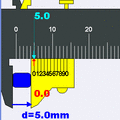Vernier scale facts for kids
A Vernier scale is a way to get a much better result when measuring how long something is or the size of an angle.
Sometimes when measuring things we need to get our measurement as accurate as possible. Accuracy is important in surveying the land, navigation of ships, making parts for machines like car engines, looking at stars and planets in astronomy and when doing experiments in science.
The working of Vernier scale
Length has been measured with a straight ruler for hundreds of years. It measures up to 0.01cm. If the object we are measuring is somewhere in between two of the marks on our ruler then we would have to estimate where between the two marks to take the measurement. A Vernier scale on our ruler does this last fine piece of measuring between the two marks for us.
So , for example if the measurement with our eye said it was between 1.5 and 1.6 centimeters, we would look at the Vernier and we would be able to say the measure is actually 1.57, something it would be vary hard to see with the eye alone.
When measuring angles the same problem occurs and a vernier may be part of a device to measure fine angles in between two of the marks on the scale.
We don't need to be sharp eyed to read the Vernier scale because its marks are almost as big as our main measuring scale. We just count how many marks there are to the next place where there is a mark on both the main and vernier scales that are exactly lined up. That number of marks tells us the size of the small extra measurement.
Images for kids
-
Vernier caliper scales; main at top, vernier at bottom. It reads 3.58 ± 0.02 mm by adding 3.00 mm (left red mark) on the fixed main scale to vernier 0.58 mm (right red mark). The main scale reading is that to the left of the zero on the vernier scale. The vernier reading is found by locating the best aligned lines between the two scales. The 0.02 mm engraving indicates the caliper's readability and is the "vernier constant" for this scale.
See also
 In Spanish: Nonio para niños
In Spanish: Nonio para niños




